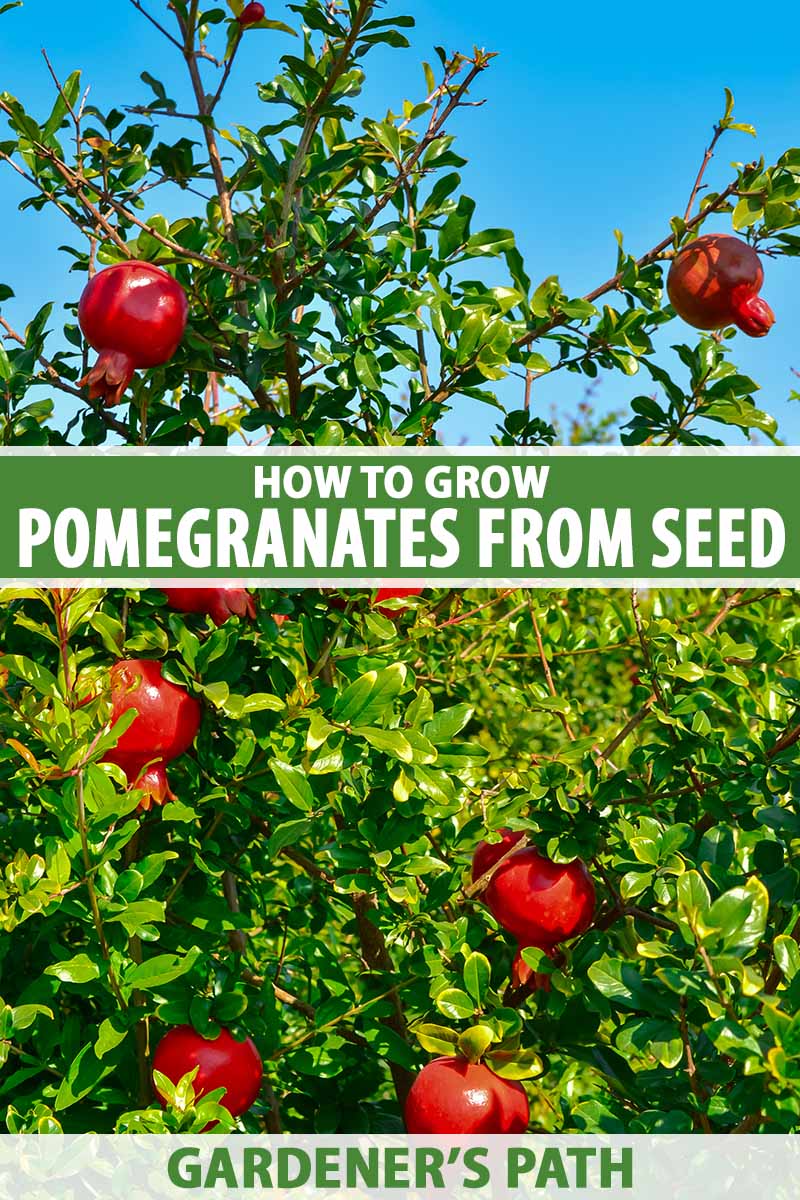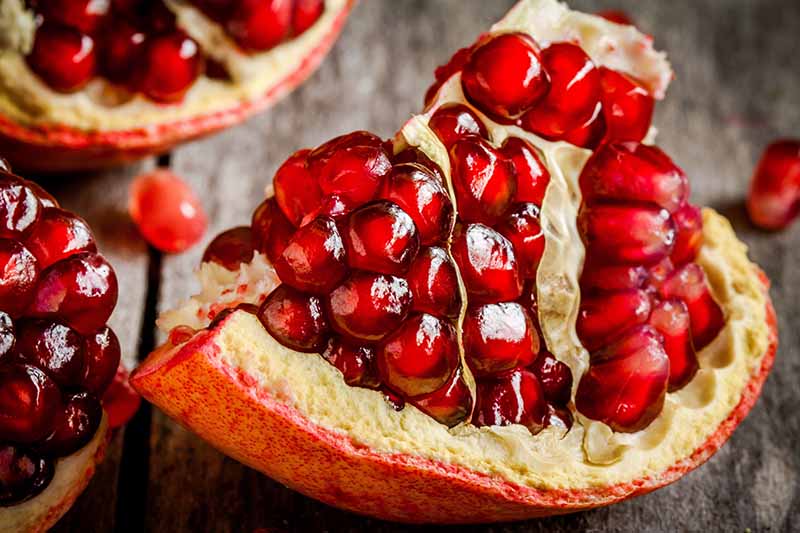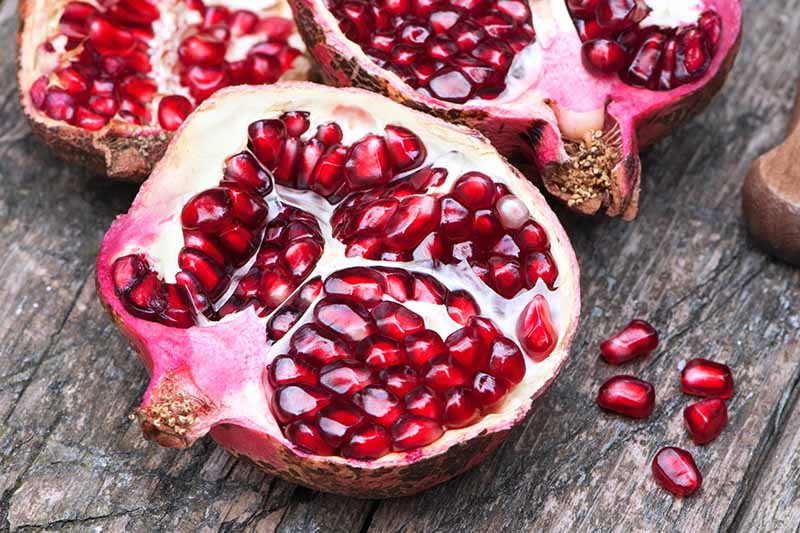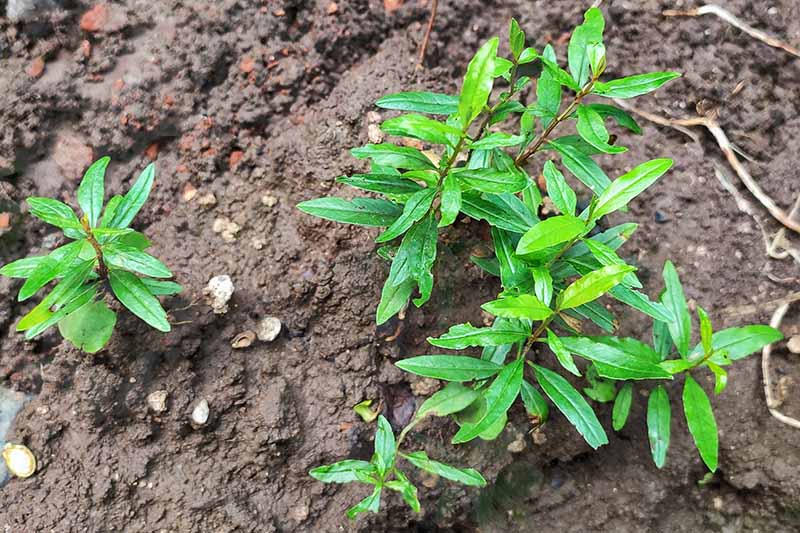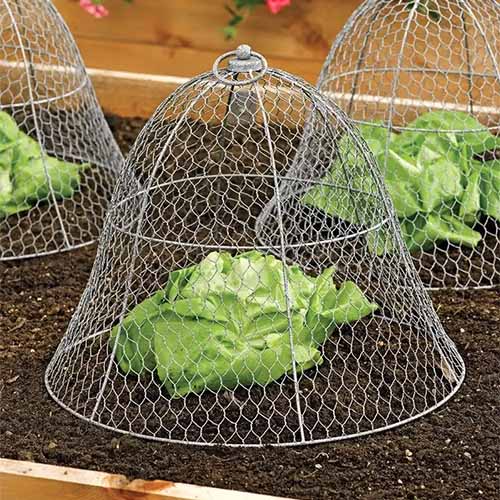The majority of fruit trees are reproduced through methods such as grafting or air layering, which produces plants that are clones of the parent. This means the fruits you’ll eventually harvest from them will be exactly like those from the parent plant. Starting with seed, on the other hand, means it’s likely that the fruit or growth habit of the tree will be unlike that of the parent plant. This is because each seed holds genetic information derived from pollination. Any time the flowers are cross-pollinated by pollen from any variety, the seeds are essentially guaranteed to produce fruit with characteristics that differ from those of the parent plant. We link to vendors to help you find relevant products. If you buy from one of our links, we may earn a commission. Even with the potential for a wide range of variation in results, it can sometimes still be worth it to experiment with seed-grown trees, as many of the more than 500 named cultivars of pomegranate are derived from variations produced by this method originally. If you’re interested in experimenting with seeds to reveal the mysteries they contain, it can be fun and may provide unique results that you’re pleased with. It’s also important to note that trees grown this way will take longer to produce fruit than those propagated via the other methods described here. It can take an average of two to five years for a tree to set edible fruit for the first time. If you’re committed to trying this method, there are a few ways to begin.
Sourcing Seeds
Pomegranate seeds are available from a few different sources. The first and most obvious option is to collect them from ripe fruits that you’ve harvested if you’ve already got a tree, or access and permission to pick fruit from someone’s else’s. Each fruit can contain hundreds of seeds, but you’ll need only a few. If you’re unsure of how to tell that fruits are ripe, take a look at our guide to harvesting pomegranates to help you understand what to look for. Remove all of the flesh from a few seeds of a mature pomegranate. You can do this by wrapping an aril in a napkin or paper towel and pressing it until the flesh has been stripped away, or simply pop it into your mouth and clean the flesh off – no waste! After removing the surrounding flesh, you’ll see that the seeds themselves are small, white, and angular, with one pointed end where the root will emerge. There’s no need to let the bare seeds dry out completely. If they do, they should not remain dry for too long or they may lose viability. It’s helpful to expose them to air for a few hours to reduce the possibility of mold developing after planting. You could also purchase a pomegranate from the produce section in the grocery store. Be sure that the fruit you choose looks healthy and well formed. Since pomegranates may be out of season in your area and aren’t always readily available from the grocery store, you might consider purchasing seeds from an online retailer. Bear in mind that you’ll need to purchase fresh seed, as those that are dried or freeze-dried may not be viable. But note that purchasing seeds online can be a gamble, because it’s difficult to tell if they were harvested from fully-ripened fruits, and if they’ve been previously frozen, they may fail to germinate.
Starting Indoors
If you live in an area where winter temperatures are much lower than they are throughout the rest of the year, it’s best to start seeds indoors during that time, as the seedlings will be ready to move outside when the spring season begins. You can plant them in a pot or direct-sow outdoors, which we’ll cover in the next section. Either will work equally well, but you should only plant outdoors in the ground if you live in a region where the tree will thrive year-round, such as in USDA Hardiness Zones 8 to 11. If you’re in an area where winter lows can fall below about 20°F, you’ll likely want to plant your tree in a container so you can move it indoors for overwintering. It’s important to note, however, that pomegranates develop a taproot that doesn’t transplant well, so you’ll need to snip it early on to encourage the root system to branch instead. We cover this in more detail in our guide to growing pomegranates in containers. (coming soon!) To plant seeds in pots, simply fill four- to six- inch pots with a mix of two parts soil to one part coarse silica sand. Adding sand will improve drainage, which is very important for this plant, as soggy soil can lead to root rot. Press one seed per pot about one-quarter inch deep into the soil and cover it over. If you’ve got biodegradable pots that you can use, those are the best choice since you won’t need to disturb the taproots when planting the trees in their permanent home. Water them just enough to moisten the soil. Keep the soil consistently moist but not wet until seedlings sprout. Place the pots in a clear container with a lid, or wrap individual pots in clear plastic bags, unless you have access to a greenhouse. The seeds need warm temperatures in the 75 to 85°F range to germinate, so if you haven’t got a suitable location, you can always use a heat mat to keep the temperature consistently warm. Remove the container or wrapping when the seeds sprout, and turn off the heat mat if you’re using one. Be sure to provide at least six to eight hours of sunlight for your seedlings. When they reach about three to four inches in height, you can transplant them to a permanent location, as the taproots will be nearly the same length as the seedlings at that point. Since your seedlings have not been exposed to outdoor conditions, you will need to move them outside gradually to harden them off. At first, only leave them out for a few hours per day in indirect sunlight. Gradually increase the length of time and amount of exposure to direct sunlight they receive each day until they’re able to spend their time permanently outdoors. Be sure to provide protection from any harsh conditions such as heavy wind or rain, as pomegranate seedlings are wispy and not able to withstand much damage.
Direct Sowing Outdoors
You can also direct sow pomegranate seeds at their permanent growing site. Choose a location that receives at least eight hours of direct sunlight per day, with good drainage and protection from seasonal low temperatures below about 40°F. Wait to plant the seeds until outdoor temperatures are consistently in the mid- to upper 70s. Most varieties grow to be about 15 to 20 feet tall at maturity, so you need to allow adequate overhead growing room. It can be difficult to predict how large a seed-grown tree might grow to be. These plants can also develop a wide canopy if they’re not pruned for size, particularly if they’re growing in their natural shrub form, so be prepared for a spread of about 12 to 20 feet. Since they can spread so widely, plan to leave about fifteen feet between trees, other plants, and nearby structures. Prepare the planting area by ensuring that the soil is loose and rich. You can rake or turn it with a cultivator or shovel, and add compost at the same time, to give plant roots some easy ground to branch out in. Luster Leaf Soil Test Kit We’ll cover fertilizing and amending soil for ideal conditions more in our guide to fertilizing pomegranate plants. It’s also a good idea to make sure the area is well weeded, and any surrounding grass is trimmed down. When the soil is ready, press the seeds about one-quarter inch deep and cover them over. Water the site until it’s just moist, but not wet, and monitor the moisture level to make sure that it doesn’t dry out completely after sowing. Young pomegranate trees are delicate plants that can easily be battered by wind and rain. These can benefit from the coverage provided by a plastic dome. Garden Cloche Plant Dome If you live in a region where temperatures are in the 70°F or above range, you may still want to protect your plants by using a wire cloche instead, as young saplings can be targets for wildlife. Chicken Wire Cloche Wire cloches are available from Gardener’s Supply Company. Once the seedlings emerge, continue to keep the soil slightly moist throughout the first year as the roots are becoming established.
If You Enjoy Surprises, Starting With Seed Is the Best Way to Grow
You could go with the reliable option of starting with cuttings, or try air layering to produce a cloned plant, but where’s the fun in that? If you’re adventurous and you have some time available to wait for the results, starting pomegranates from seed can be a rewarding project. It’s also pretty exciting to imagine that you might end up with a new variety of pomegranate that people love – perhaps it’ll be named after you! Are you planning to start some seeds? We want to know, and to see pictures of your results, so don’t forget to post them in the comments section below! And if you’ve still got some research to do before you feel sure about planting a pomegranate tree, we have the answers to your questions in these articles:
How to Grow and Care for PomegranatesWhat Causes Pomegranate Fruits to Crack or Split?How to Identify and Control Pomegranate Pests and Diseases
